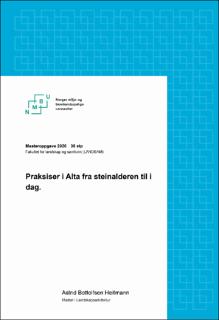| dc.contributor.advisor | Fiskevold, Marius | |
| dc.contributor.author | Heitmann, Astrid Bottolfsen | |
| dc.coverage.spatial | Norway, Finnmark, Alta | en_US |
| dc.date.accessioned | 2021-01-31T16:46:54Z | |
| dc.date.available | 2021-01-31T16:46:54Z | |
| dc.date.issued | 2020 | |
| dc.identifier.uri | https://hdl.handle.net/11250/2725448 | |
| dc.description.abstract | Bakgrunn for oppgaven er at mange mennesker har tatt i bruk Altalandet fra de første menneskene kom dit for 11.400 år siden og fram til i dag. Oppgaven forsøker å ta for seg noen praksiser som har vært til stede gjennom denne tidsperioden, og om disse reflekteres i bruken av området i dag.
Kvalitative litteraturstudier, intervjuer og feltarbeid i Alta danner grunnlaget for oppgavens kunnskapsgrunnlag. Her gis det et innblikk i den eldre steinalderens praksis, samisk praksis, kvensk praksis, norsk skiferbondepraksis, kobberverksdrift, tysk okkupasjonspraksis, og nordlysforskningspraksis, Loranges planleggerpraksis, Kraftbyggings praksis og gjeldende arealplanpraksis.
Oppgaven diskuterer empirien i lys av teoriene om Jakob Meløes landskap som praksis, Martin Heideggers moderne teknikk og Joachim Ritters natur som landskap. Diskusjonen er delt inn i hvordan de ulike praksiser tar i bruk de stedlige elementene havet, elva, skogen, jorda, berget, og om de er systempraksiser/ teknisk baserte praksiser eller landskapspraksiser.
Oppgaven kom fram til at bruken av Altalandet lenge preges av landskapspraksiser som er basert på en tilpasning til naturkreftene og de stedlige elementene i Alta.
Utover på 1800-tallet kommer det derimot stadig flere teknisk baserte praksiser som i økende grad tilpasser Altalandet til egen praksis. Innslaget av mer universelle tekniske praksiser som ikke har det stedlige ved Alta som utgangspunkt, men et menneskelig system, kjennetegner mange av disse. Samt har flere av disse praksisene innebygget en svært kalkulerende, regulerende og dominerende framferd og måte å ta landet i bruk på.
Parallelt med- og med en grobunn i systempraksisene framtrer det andre rekreasjonspraksiser som vi kan kalle en moderne estetisk tilnærming til naturen. Dens funksjon er å hele den tapte helhetlige relasjonen til naturen for det moderne mennesket.
Videre er det svake spor igjen av landskapspraksiser i arealplanpraksisen i Alta i dag, ikke i bruken den åpner opp for og absolutt ikke i selve institusjonen. Arealplanpraksisen som institusjon har derimot store likheter med de andre mer universelle og regulerende systempraksisene som vokste fram på 1800 tallet. | en_US |
| dc.description.abstract | The background for the thesis is that Alta has housed many practices from the ending of the last ice age until today. The thesis tries to address some of the practices that have been present during this time period, and if they are reflected in the use of the area today.
Qualitative literature studies, interviews and fieldwork in Alta form the basis for the thesis knowledge. And gives an insight into older Stone Age practice, Sami practice, Kven practice, Norwegian slate farmer practice, copperworks practice, German occupation practice, and Northern Lights research practice, Lorange's planning practice, hydroelectric power practice and current land-use practice.
The thesis discusses this knowledge considering the theories about Jakob Meløe's landscape as practice, Martin Heidegger's modern technique and Joachim Ritter's nature as landscape. The discussion is divided into how the different practices cultivate the local elements in the sea, river, forest, earth, rock and if they are system practices / technically based practises or landscape practices.
The task found out that the use of Altalandet long was characterized by being landscape practices that were based on an adaptation to the forces of nature and the local elements in Alta.
Throughout the 19th century there arrive more and more technically based practices that organize and adapt Altalandet to their own practices. They often have a more universal technical character that doesn’t have Alta as its starting point but correspond more to human mental constructions. Several of these practices also have built-in, very regulatory and dominant frameworks in order to take the country into use.
Almost at the same time with a kind of common breeding ground with these system practices, other recreational practices emerge that we can call a kind of modern aesthetic approach to nature. Its function is to heal the lost holistic relationship with nature for modern man.
There are weak traces left of the landscape practices in the land-use planning today, not in the use it unlocks and certainly not in the institution itself. The spatial planning practice as an institution, on the other hand, has great similarities with the other more universal and regulatory system practices that emerged in the 19th century | en_US |
| dc.language.iso | nob | en_US |
| dc.publisher | Norwegian University of Life Sciences, Ås | en_US |
| dc.rights | Attribution-NonCommercial-NoDerivatives 4.0 Internasjonal | * |
| dc.rights.uri | http://creativecommons.org/licenses/by-nc-nd/4.0/deed.no | * |
| dc.title | Praksiser i Alta fra steinalderen til i dag | en_US |
| dc.title.alternative | Practices from stone age until today | en_US |
| dc.type | Master thesis | en_US |
| dc.source.pagenumber | 133 | en_US |
| dc.description.localcode | M-LA | en_US |

